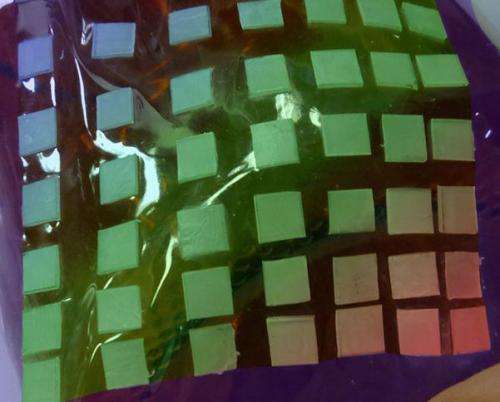December 13, 2012 report
Checkerboard surface put to flexible electronics test

(Phys.org)—Interest mounts in stretchable electronics, seen as the future direction in mobile electronics. How long before manufacturing giants load retail shelves with devices that have stretchable electronics is anyone's guess, but beyond stretchy tablets and foldable pocket phones, think about a range of applications such as wearable computing, materials that could improve medical techniques, and even dental implants. Progress is being made in labs to figure out practical ways to develop bendable and stretchy products. A research area in interesting substrates and elastomeric materials is growing up; a notable research feat presents a solution to resolve the nagging problem in making stretchy electronics practical—that problem is breakage.
While circuits and wiring behave well on rigid surfaces, the challenge is in electronics that can bend and stretch but not break. Fragile electronic circuits if subjected to bending on a flexible board may not hold up. A research team at ETH in Zurich, Switzerland, have taken on the challenge of breakage. They have devised a novel surface that has both stiff and flexible regions. It has been likened to a checkerboard or tiny islands of rigid electronic components embedded into a flexible surface that can be stretched beyond its normal length. The technique makes it possible to keep stiff circuit boards safe from kinks. Rather than alter the electronics themselves, the study team chose to make a surface for the electronics to sit on. Using both stretchy and stiff regions, the stiff regions protect the still-rigid electronic circuits. Authors of the research, "Stretchable heterogeneous composites with extreme mechanical gradients," published in the journal Nature Communications, said that "the development of heterogeneous synthetic composites with locally tuned elastic properties would allow us to extend the lifetime of functional devices with mechanically incompatible interfaces, and to create new enabling materials for applications ranging from flexible electronics to regenerative medicine."
Their surface is of polyurethane. To accomplish both stretchy and stiff properties, the team worked with several layers. The bottom layer is the most flexible, of "undoped" polyurethane. The middle layer has polyurethane with laponite. The topmost layer is doped with aluminum and is the most rigid. The bottom, most stretchy, layer is a large sheet, and the stiffer ones are placed in cut-out squares and bonded to the undoped layer. To test the approach, the team installed an LED circuit on the stiff island. It remained lit even when the sheet was significantly stretched.
The team's work could be a true step in making flexible electronics capable of serving practical applications. "We designed and produced composites exhibiting regions with extreme soft-to-hard transitions, while still being reversibly stretchable up to 350%."
One potential application, according to the researchers, could be building synthetic cartilage or false teeth that could resolve the problem of ceramics that are too hard. Co-author André Studart, professor of complex materials at the Swiss Federal Institute of Technology (ETH), said that "The vision is that you will be able to make materials that are as heterogeneous as the biological ones."
More information: Stretchable heterogeneous composites with extreme mechanical gradients, Nature Communications 3, Article number: 1265 doi:10.1038/ncomms2281
Abstract
Heterogeneous composite materials with variable local stiffness are widespread in nature, but are far less explored in engineering structural applications. The development of heterogeneous synthetic composites with locally tuned elastic properties would allow us to extend the lifetime of functional devices with mechanically incompatible interfaces, and to create new enabling materials for applications ranging from flexible electronics to regenerative medicine. Here we show that heterogeneous composites with local elastic moduli tunable over five orders of magnitude can be prepared through the site-specific reinforcement of an entangled elastomeric matrix at progressively larger length scales. Using such a hierarchical reinforcement approach, we designed and produced composites exhibiting regions with extreme soft-to-hard transitions, while still being reversibly stretchable up to 350%. The implementation of the proposed methodology in a mechanically challenging application is illustrated here with the development of locally stiff and globally stretchable substrates for flexible electronics.
Journal information: Nature Communications
© 2012 Phys.org



















